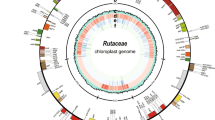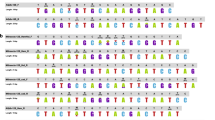Abstract
Ribes odoratum, commonly known as clove currant, is a perennial deciduous shrub noted for its long-lasting fragrant flowers and edible fruits. Owing to its ornamental values, this species has been widely used in city gardening and urban landscaping. Here, the complete cp genome of R. odoratum was de novo assembled for the first time. The plastome is 157,152 bp in length, with a GC content of 38.2%. The cp genome featured a typical quadripartite structure, consisting of a pair of inverted repeat regions of 25,961 bp, separated by a large single copy region of 86,896 bp, and a small single copy region of 18,333 bp. A total of 131 genes were annotated in the plastome, including 86 protein coding genes, 37 tRNA genes, and 8 rRNA genes. 56 SSRs were identified, among which, 82.35% were located in the intergenic regions. A strong A/T bias in base composition was observed in these cpSSRs. In addition, 49 repeats of different sizes and types were also found in the plastome. Through comparison, seven divergence hotspots were identified between the cp genomes of R. odoratum and R. fasciculatum var. chinense. Sequences of these divergent regions could be developed as potential markers for species delimitation in further studies. We re-investigated the relationship aomong 32 Saxifragales species through plastome-based phylogenywhich revealed that R. odoratum as a sister of R. fasciculatum var. chinense. Thus, our study provides genomic resources and valuable reference for marker development and phylogenomics in Ribes.







Similar content being viewed by others
Availability of data and material
The raw data that support the findings of this research have been deposited in the CNSA (https://db.cngb.org/cnsa/) of CNGBdb under the Accession Number of CNP0001052.
References
Amiryousefi A, Hyvönen J, Poczai P (2018) IRscope: An online program to visualize the junction sites of chloroplast genomes. Bioinformatics (Oxford, England). https://doi.org/10.1093/bioinformatics/bty220
Bate-Smith EC (1976) Chemistry and taxonomy of ribes. Biochem Syst Ecol 4:13–23. https://doi.org/10.1016/0305-1978(76)90004-1
Bensel CR, Palser BF (1975) Floral anatomy in the Saxifragaceae sensu lato. II. Saxifragoideae and iteoideae. Am J Bot 62:661–675. https://doi.org/10.2307/2442055
Bobik K, Burch-Smith TM (2015) Chloroplast signaling within, between and beyond cells. Front Plant Sci. https://doi.org/10.3389/fpls.2015.00781
Dickison WC, Hils MH, Lucansky TW, Stern WL (1994) Comparative anatomy and systematics of woody Saxifragaceae. Aphanopetalum Endl Bot J Linn Soc 114:167–182. https://doi.org/10.1006/bojl.1994.1011
Dierckxsens N, Mardulyn P, Smits G (2016) NOVOPlasty: de novo assembly of organelle genomes from whole genome data. Nucleic Acids Res 45:e18–e18. https://doi.org/10.1093/nar/gkw955
Dong W, Liu J, Yu J, Wang L, Zhou S (2012) Highly variable chloroplast markers for evaluating plant phylogeny at low taxonomic levels and for DNA barcoding. PLoS ONE 7:e35071–e35071. https://doi.org/10.1371/journal.pone.0035071
Dong W, Xu C, Wu P, Cheng T, Yu J, Zhou S, Hong D-Y (2018) Resolving the systematic positions of enigmatic taxa: manipulating the chloroplast genome data of Saxifragales. Mol Phylogenet Evol. https://doi.org/10.1016/j.ympev.2018.04.033
Du X et al (2020) The complete chloroplast genome sequence of yellow mustard (Sinapis alba L.) and its phylogenetic relationship to other Brassicaceae species. Gene 731:144340. https://doi.org/10.1016/j.gene.2020.144340
Du YP, Bi Y, Yang FP, Zhang MF, Chen XQ, Xue J, Zhang XH (2017) Complete chloroplast genome sequences of Lilium: insights into evolutionary dynamics and phylogenetic analyses. Sci Rep 7:5751. https://doi.org/10.1038/s41598-017-06210-2
Gao K et al (2019) Comparative genomic and phylogenetic analyses of Populus section Leuce using complete chloroplast genome sequences. Tree Genet Genom 15:32. https://doi.org/10.1007/s11295-019-1342-9
Grassi F, Labra M, Scienza A, Imazio S (2002) Chloroplast SSR markers to assess DNA diversity in wild and cultivated grapevines. Vitis-Geilweilerhof- 41:157–158
Greiner S, Lehwark P, Bock R (2019) OrganellarGenomeDRAW (OGDRAW) version 1.3.1: expanded toolkit for the graphical visualization of organellar genomes. Nucleic Acids Res 47:W59–W64. https://doi.org/10.1093/nar/gkz238
Group TAP et al (2016) An update of the Angiosperm Phylogeny Group classification for the orders and families of flowering plants APG IV. Bot J Linn Soc 181:1–20. https://doi.org/10.1111/boj.12385
Gui L, Jiang S, Xie D, Yu L, Huang Y, Zhang Z, Liu Y (2020) Analysis of complete chloroplast genomes of Curcuma and the contribution to phylogeny and adaptive evolution. Gene 732:144355. https://doi.org/10.1016/j.gene.2020.144355
Hahn C, Bachmann L, Chevreux B (2013) Reconstructing mitochondrial genomes directly from genomic next-generation sequencing reads—a baiting and iterative mapping approach. Nucleic Acids Res 41:e129–e129. https://doi.org/10.1093/nar/gkt371
Huang Pu-Hwa YW-H (1989) Pollen morphology of Ribes L. and its taxonomic significance. J Syst Evol 27:378–385
Hummer KE, Dale A (2010) Horticulture of ribes. For Pathol 40:251–263. https://doi.org/10.1111/j.1439-0329.2010.00657.x
Katoh K, Standley DM (2013) MAFFT multiple sequence alignment software version 7: improvements in performance and usability. Mol Biol Evol 30:772–780. https://doi.org/10.1093/molbev/mst010
Keep E (1963) Interspecific hybridization in ribes. Genetica 33:1–23. https://doi.org/10.1007/BF01725743
Kumar S, Stecher G, Li M, Knyaz C, Tamura K (2018) MEGA X: molecular evolutionary genetics analysis across computing platforms. Mol Biol Evol 35:1547–1549. https://doi.org/10.1093/molbev/msy096
Kurtz S, Choudhuri JV, Ohlebusch E, Schleiermacher C, Stoye J, Giegerich R (2001) REPuter: the manifold applications of repeat analysis on a genomic scale. Nucleic Acids Res 29:4633–4642. https://doi.org/10.1093/nar/29.22.4633
Langmead B, Salzberg SL (2012) Fast gapped-read alignment with Bowtie 2. Nat Methods 9:357–359. https://doi.org/10.1038/nmeth.1923
Li H, Durbin R (2009) Fast and accurate short read alignment with Burrows–Wheeler transform. Bioinformatics 25:1754–1760. https://doi.org/10.1093/bioinformatics/btp324
Liu LX, Du YX, Folk RA, Wang SY, Soltis DE, Shang FD, Li P (2020) Plastome evolution in Saxifragaceae and multiple plastid capture events involving Heuchera and Tiarella. Front Plant Sci 11:361. https://doi.org/10.3389/fpls.2020.00361
Mayor C et al (2000) VISTA: visualizing global DNA sequence alignments of arbitrary length. Bioinformatics 16:1046–1047. https://doi.org/10.1093/bioinformatics/16.11.1046
McKain M, Johnson M, Uribe-Convers S, Eaton D, Yang Y (2018) Practical considerations for plant phylogenomics. Appl Plant Sci. https://doi.org/10.1002/aps3.1038
Millen RS et al (2001) Many parallel losses of infA from chloroplast DNA during angiosperm evolution with multiple independent transfers to the nucleus. Plant Cell 13:645–658. https://doi.org/10.1105/tpc.13.3.645
Palmer J (1990) Plastid chromosomes: structure and evolution cell culture and somatic cell genetics of plants. Mol Biol Plastids. https://doi.org/10.1016/B978-0-12-715007-9.50009-8
Patel RK, Jain M (2012) NGS QC toolkit: a toolkit for quality control of next generation sequencing data. PLoS ONE 7:e30619. https://doi.org/10.1371/journal.pone.0030619
Pikunova AV, Martirosian EV, Kniazev SD, Ryzhova NN (2012) Application of the RAPD-analysis for the study of genetic polymorphism and phylogenetic relationships in the Ribes L. genus. Russ J Genet Appl Res 2:141–151. https://doi.org/10.1134/S2079059712020098
Posada D (2008) jModelTest: phylogenetic model averaging. Mol Biol Evol 25:1253–1256. https://doi.org/10.1093/molbev/msn083
Raubeson L, Jansen R (2005) Chloroplast genomes of plants, plant diversity and evolution: genotypic and phenotypic variation in higher plants. Diversity and evolution of plants-genotypic and phenotypic variation in higher plants, vol 3. CABI Publishing, London. https://doi.org/10.1079/9780851999043.0045
Roston RL, Jouhet J, Yu F, Gao H (2018) Editorial: structure and function of chloroplasts. Front Plant Sci 9:1656–1656. https://doi.org/10.3389/fpls.2018.01656
Rozas J, Ferrer-Mata A, Sanchez-DelBarrio JC, Guirao-Rico S, Librado P, Ramos-Onsins SE, Sanchez-Gracia A (2017) DnaSP 6: DNA sequence polymorphism analysis of large data sets. Mol Biol Evol 34:3299–3302. https://doi.org/10.1093/molbev/msx248
Schultheis L (2009) Molecular phylogeny and biogeography of ribes (Grossulariaceae), with an emphasis on gooseberries (subg. Grossularia). Syst Bot 29:77–96. https://doi.org/10.1600/036364404772974239
Senters AE, Soltis DE (2003) Phylogenetic relationships in Ribes (Grossulariaceae) inferred from ITS sequence data. Taxon 52:51–66. https://doi.org/10.2307/3647437
Shi L, Chen H, Jiang M, Wang L, Wu X, Huang L, Liu C (2019) CPGAVAS2, an integrated plastome sequence annotator and analyzer. Nucleic Acids Res. https://doi.org/10.1093/nar/gkz345
Somaratne Y, Guan D-L, Wang W-Q, Zhao L, Xu S-Q (2019) Complete chloroplast genome sequence of Xanthium sibiricum provides useful DNA barcodes for future species identification and phylogeny. Plant Syst Evol 305:949–960. https://doi.org/10.1007/s00606-019-01614-1
Stegemann S, Hartmann S, Ruf S, Bock R (2003) High-frequency gene transfer from the chloroplast genome to the nucleus. Proc Natl Acad Sci USA 100:8828–8833. https://doi.org/10.1073/pnas.1430924100
Tillich M, Lehwark P, Pellizzer T, Ulbricht-Jones E, Fischer A, Bock R, Greiner S (2017) GeSeq—versatile and accurate annotation of organelle genomes. Nucleic Acids Res. https://doi.org/10.1093/nar/gkx391
Turmel M, Otis C, Lemieux C (2015) Dynamic evolution of the chloroplast genome in the green algal classes pedinophyceae and trebouxiophyceae. Genome Biol Evol 7:2062–2082. https://doi.org/10.1093/gbe/evv130
Ueda M, Fujimoto M, Arimura S, Murata J, Tsutsumi N, Kadowaki K (2007) Loss of the rpl32 gene from the chloroplast genome and subsequent acquisition of a preexisting transit peptide within the nuclear gene in Populus. Gene 402:51–56. https://doi.org/10.1016/j.gene.2007.07.019
Vieira M-L, Santini L, Lima Diniz A, Munhoz C (2016) Microsatellite markers: What they mean and why they are so useful. Genet Mol Biol. https://doi.org/10.1590/1678-4685-GMB-2016-0027
Walker BJ et al (2014) Pilon: an integrated tool for comprehensive microbial variant detection and genome assembly improvement. PLoS ONE 9:e112963. https://doi.org/10.1371/journal.pone.0112963
Wellington Santos M (2009) WebSat—a web software for microsatellite marker development. Bioinformation 6:282
Wu Z, Liao R, Yang T, Dong X, Lan D, Qin R, Liu H (2020) Analysis of six chloroplast genomes provides insight into the evolution of Chrysosplenium (Saxifragaceae). BMC Genom 21:621. https://doi.org/10.1186/s12864-020-07045-4
Xia X (2018) DAMBE7: new and improved tools for data analysis in molecular biology and evolution. Mol Biol Evol 35:1550–1552. https://doi.org/10.1093/molbev/msy073
Yan C, Du J, Gao L, Li Y, Hou X (2019) The complete chloroplast genome sequence of watercress (Nasturtium officinale R. Br.): genome organization, adaptive evolution and phylogenetic relationships in Cardamineae. Gene 699:24–36. https://doi.org/10.1016/j.gene.2019.02.075
Zang M et al (2019) Complete chloroplast genome of Fokienia hodginsii (Dunn) Henry et Thomas: insights into repeat regions variation and phylogenetic relationships in Cupressophyta. Forests. https://doi.org/10.3390/f10070528
Zdunić G, Šavikin K, Pljevljakušić D, Djordjević B (2016) Chapter 5—Black (Ribes nigrum L.) and red currant (Ribes rubrum L.) cultivars. In: Simmonds MSJ, Preedy VR (eds) Nutritional composition of fruit cultivars. Academic Press, San Diego, pp 101–126. https://doi.org/10.1016/B978-0-12-408117-8.00005-2
Zhang Y et al (2016) The complete chloroplast genome sequences of five epimedium species: lights into phylogenetic and taxonomic analyses. Front Plant Sci 7:306. https://doi.org/10.3389/fpls.2016.00306
Acknowledgements
This research was supported by Science and Technology Project of Qinghai Province (2019-ZJ-962Q; 2019-NK-106; 2017-NK-151; 2016-ZJ-Y01), The Open Project of State Key Laboratory of Plateau Ecology and Agriculture, Qinghai University (2019-ZZ-05), and The Youth Foundation of Qinghai University (2019-QNY-2).
Author information
Authors and Affiliations
Contributions
LW designed and supervised the Project, reviewed drafts of the paper; LW and JL conceived the idea, analyzed the data and wrote the original draft manuscript; LW analyzed the data and checked and revised the manuscript; JL and WS participated in analyzing the data and drew some figures and tables; LW collected the samples and provided some advice.
Corresponding author
Ethics declarations
Conflict of interest
The authors declare that they have no conflict of interest.
Additional information
Publisher's Note
Springer Nature remains neutral with regard to jurisdictional claims in published maps and institutional affiliations.
Supplementary information
Below is the link to the supplementary information.
Rights and permissions
About this article
Cite this article
Wang, L., Liang, J., Sa, W. et al. Sequencing and comparative analysis of the chloroplast genome of Ribes odoratum provide insights for marker development and phylogenetics in Ribes. Physiol Mol Biol Plants 27, 81–92 (2021). https://doi.org/10.1007/s12298-021-00932-4
Received:
Revised:
Accepted:
Published:
Issue Date:
DOI: https://doi.org/10.1007/s12298-021-00932-4




